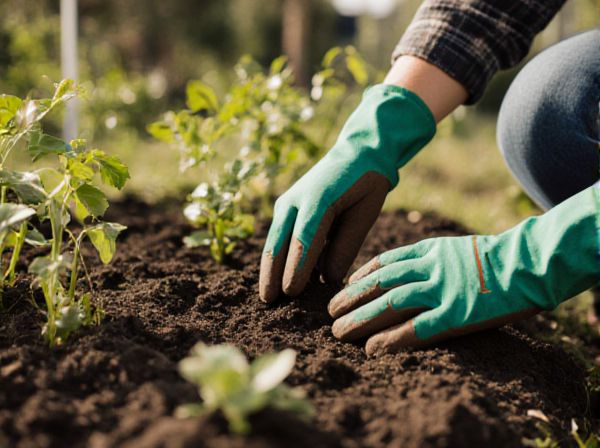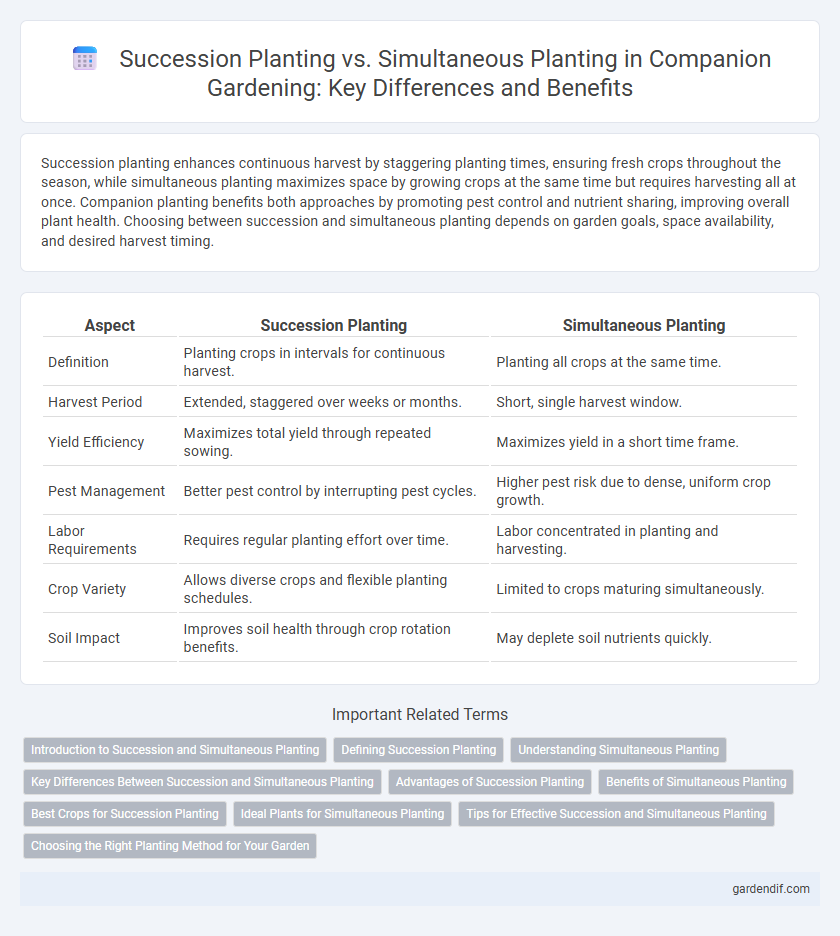
Succession planting vs simultaneous planting Illustration
Succession planting enhances continuous harvest by staggering planting times, ensuring fresh crops throughout the season, while simultaneous planting maximizes space by growing crops at the same time but requires harvesting all at once. Companion planting benefits both approaches by promoting pest control and nutrient sharing, improving overall plant health. Choosing between succession and simultaneous planting depends on garden goals, space availability, and desired harvest timing.
Table of Comparison
| Aspect | Succession Planting | Simultaneous Planting |
|---|---|---|
| Definition | Planting crops in intervals for continuous harvest. | Planting all crops at the same time. |
| Harvest Period | Extended, staggered over weeks or months. | Short, single harvest window. |
| Yield Efficiency | Maximizes total yield through repeated sowing. | Maximizes yield in a short time frame. |
| Pest Management | Better pest control by interrupting pest cycles. | Higher pest risk due to dense, uniform crop growth. |
| Labor Requirements | Requires regular planting effort over time. | Labor concentrated in planting and harvesting. |
| Crop Variety | Allows diverse crops and flexible planting schedules. | Limited to crops maturing simultaneously. |
| Soil Impact | Improves soil health through crop rotation benefits. | May deplete soil nutrients quickly. |
Introduction to Succession and Simultaneous Planting
Succession planting involves strategically planting crops at intervals to ensure continuous harvests and efficient use of garden space, optimizing yield over time. Simultaneous planting refers to growing multiple crops at the same time in a shared area, promoting biodiversity and mutual pest control through companion planting principles. Understanding these methods enhances productivity and sustainability in companion gardening by aligning planting schedules and plant compatibility.
Defining Succession Planting
Succession planting involves staggered sowing of crops to ensure continuous harvests throughout the growing season, optimizing garden space and yield. Unlike simultaneous planting, where all seeds are sown at once, succession planting schedules seedings at regular intervals, enhancing crop rotation and pest management. This method maximizes resource use and maintains soil fertility by alternating plant species with different nutrient demands.
Understanding Simultaneous Planting
Simultaneous planting involves sowing multiple crop species at the same time, optimizing space and resource use by leveraging complementary growth habits and nutrient needs. This method enhances pest control and soil health through diverse root structures and canopy layers that promote beneficial insect habitats and reduce disease spread. Understanding simultaneous planting principles helps gardeners and farmers maximize yield and sustainability by aligning plant life cycles and biological interactions effectively.
Key Differences Between Succession and Simultaneous Planting
Succession planting involves sowing crops at intervals to ensure continuous harvest over time, optimizing garden space and prolonging productivity. Simultaneous planting, by contrast, means planting all seeds or seedlings at the same time to achieve a uniform harvest period, which simplifies management but may result in a shorter overall harvest window. Key differences include timing, harvest scheduling, and crop yield distribution, with succession planting maximizing steady supply and simultaneous planting focusing on bulk yield.
Advantages of Succession Planting
Succession planting maximizes garden productivity by allowing continuous harvests throughout the growing season, unlike simultaneous planting which yields a single crop cycle. It reduces the risk of crop failure by staggering planting times, helping to avoid pests, diseases, and unfavorable weather conditions. This method also optimizes space and soil nutrients by cycling compatible crops, enhancing overall garden health and yield.
Benefits of Simultaneous Planting
Simultaneous planting in companion gardening maximizes space utilization by growing complementary plants at the same time, leading to improved pest control and enhanced nutrient sharing within the soil. This method encourages biodiversity, which strengthens plant resilience and promotes healthier, more productive crops. By aligning growth cycles, simultaneous planting also facilitates synchronized harvesting, optimizing garden management and yield efficiency.
Best Crops for Succession Planting
Succession planting maximizes garden yield by staggering crop planting times, allowing continuous harvests throughout the season, especially with fast-growing crops like lettuce, radishes, and spinach. Simultaneous planting involves sowing all crops at once, ideal for long-season crops like tomatoes or peppers but less efficient for space and time optimization. Best crops for succession planting include leafy greens, bush beans, carrots, and herbs such as basil, which thrive with repeated sowings to extend harvest periods and improve soil utilization.
Ideal Plants for Simultaneous Planting
Ideal plants for simultaneous planting in companion gardening include fast-growing crops like radishes, lettuce, and spinach, which mature quickly and can be harvested before slower-growing plants such as tomatoes and peppers require more space. Legumes like beans and peas pair well when planted simultaneously with corn or squash, facilitating nitrogen fixation and maximizing garden productivity. Herbs such as basil and marigold enhance pest control and improve the overall health of primary crops, making them excellent choices for synchronized planting schedules.
Tips for Effective Succession and Simultaneous Planting
Succession planting maximizes garden productivity by staggering crop intervals, ensuring continuous harvests and efficient space use. Simultaneous planting supports companion planting strategies, promoting pest control and nutrient sharing among compatible plants. To optimize results, select crop varieties with complementary growth cycles and nutrient needs, water consistently, and monitor soil health for balanced fertility.
Choosing the Right Planting Method for Your Garden
Succession planting enhances garden productivity by staggering crop cycles, ensuring a continuous harvest and efficient use of space throughout the growing season. Simultaneous planting focuses on planting different crops at the same time, ideal for maximizing space with complementary plants that support each other's growth through companion planting. Selecting the right method depends on your garden's size, desired harvest frequency, and crop compatibility to optimize yield and maintain soil health.
Succession planting vs simultaneous planting Infographic

 gardendif.com
gardendif.com